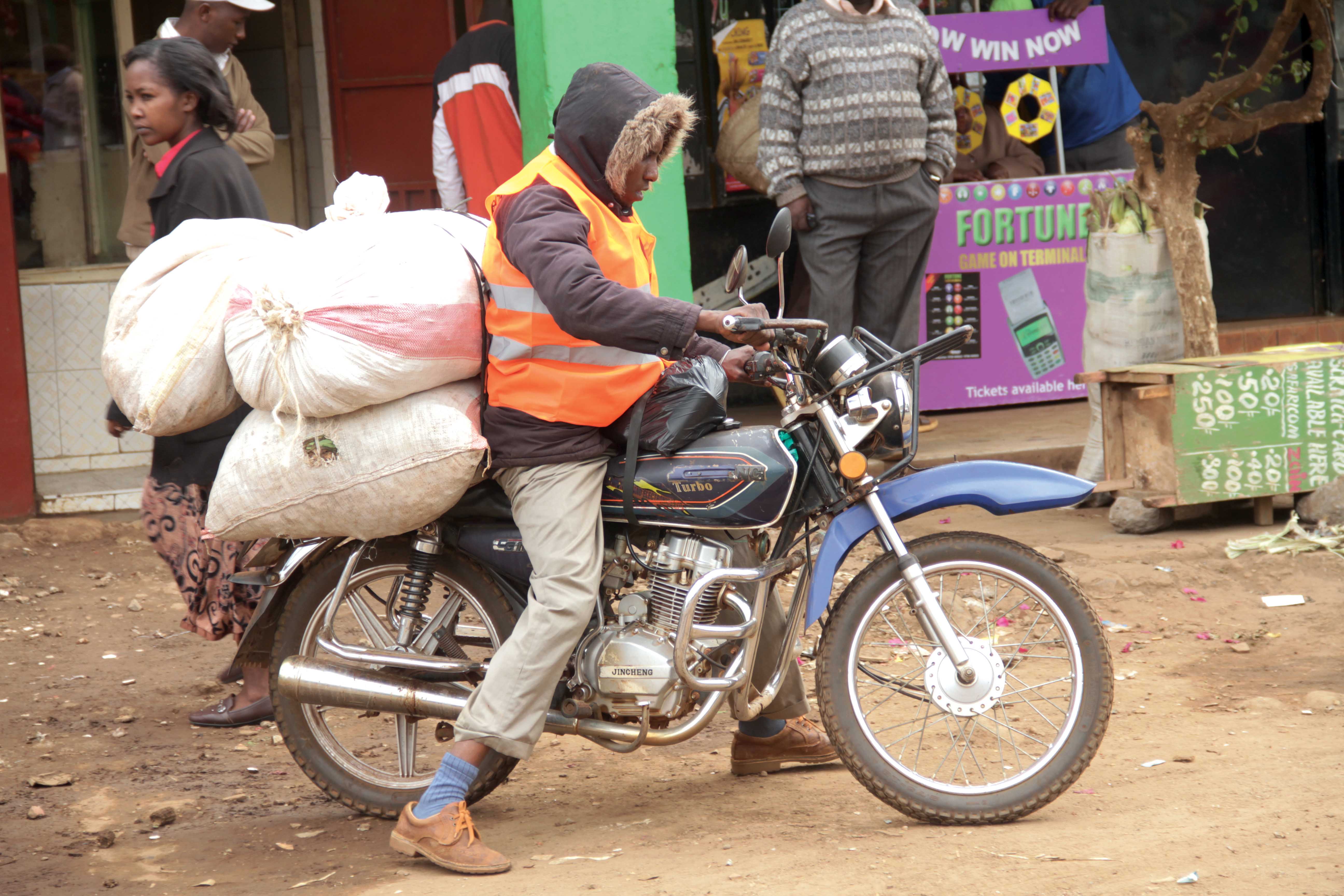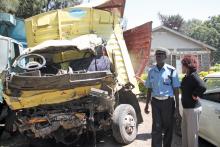Kenya’s many motorcycle taxis have an unenviably poor record for road safety - Shem Oirere writes. A state-owned road safety agency in Kenya is grappling with enforcement of new traffic regulations aimed at reducing the number of road accidents involving two-wheeled motorcycle taxis, popularly known as boda boda. The latest statistics indicate that fatalities relating to these vehicles shot up by 58% during the first four months of 2015.
Experts have concurred with a previous study by the World Health Or

Kenya’s motorcycle taxis, or boda boda, have an unenviable reputation for frequent crashes
Kenya’s many motorcycle taxis have an unenviably poor record for road safety - Shem Oirere writes
A state-owned road safety agency in Kenya is grappling with enforcement of new traffic regulations aimed at reducing the number of road accidents involving two-wheeled motorcycle taxis, popularly known as boda boda. The latest statistics indicate that fatalities relating to these vehicles shot up by 58% during the first four months of 2015.
Experts have concurred with a previous study by the3263 World Health Organisation (WHO) that expressed concern at the high number of motorcycle crashes. Investigations reveal riders and pillion passengers ignoring traffic rules and failing to observe basic safety precautions such as wearing helmets and reflector jackets.
The National Transport and Safety Authority (NTSA), a state-owned agency mandated to manage road transport in Kenya, said deaths caused by motorcycle taxis increased by 19% in 2014 compared to 2013.
Mathew Munyao, NTSA road safety director said that 391 riders and 162 pillion passengers died in road crashes between January and March 2014.
NTSA statistics indicate that between January and March 2015, at least 131 people died in crashes, including 93 boda boda riders and 38 passengers.
Within the first three months of the year, 112 motorcycle riders and 51 passengers were injured in road crashes according to NTSA.
“Most of the riders do not have licences while others do not wear helmets or even reflector jackets,” said Dolly Oduor, the Nairobi traffic operations officer.
The situation could get worse according to NTSA director general Francis Meja who warned, “With the completion of high-speed and high-impact roads in Nairobi, there is risk of increased serious and fatal injuries.”
In a bid to enhance safety in Kenya’s motorcycle taxi business, NTSA has announced new measures. These include compelling suppliers and dealers of two- and three-wheeled motorcycles to ensure they only sell vehicles complete with two helmets and two reflective jackets. Helmets and jackets should bear the registration number of the motorcycle.
“No supplier, distributor or person involved in the business of selling motorcycles in Kenya shall sell, distribute or otherwise convey a motorcycle without the protective gear,” the regulations say. They were signed by Transport and Infrastructure Cabinet secretary Michael Kamau. In addition, owners of motorcycles must ensure only riders who hold a valid driving licence or a valid provisional licence endorsed in respect of that class of motorcycle is permitted to ride the motorcycle.
Under the new regulations all riders to have a public service vehicle (PSV) insurance, a valid license and minimum third party insurance. The agency says all riders must now be registered by the authority.
The regulations also restrict the carriage of loads to 15cm width beyond the handle bars, to a height of 2m from the ground, and with no rear projection extending more than 60cm beyond the end of the motorcycle. The regulations also forbid loads dragging on the road. NTSA also has limited the number of passengers to one who, with the exception of someone with a disability, "must sit astride and use foot rests".
Although the measures are meant to reduce motorcycle fatalities on Kenyan highways, the director of road safety Mathew Munyua added, “There is still need for a complete change of behaviour and attitude on the roads.”
“Boda boda riders need to be aware of the risks they are exposed to on the roads for themselves and for the passengers they carry. Proper training and adherence to traffic rules is not an option.”
The new regulations are likely to streamline Kenya’s two-wheeled taxi business and ensure policy certainty in an industry stakeholders have said has hitherto been ignored in the country’s transport sector planning.
“For two-wheeler motorcycle taxis, the name of the group or savings and credit cooperative which they are members of must be indelibly printed in letters not less than 10.2cm in height on the back of both jackets,” NTSA regulations say.
Former Communications permanent secretary Dr Bitange Ndemo said that the time has come for Kenya “to regulate the supply and use of motorcycles, emphasising on road use training by a competent authority before they are allowed to carry any passengers.
“Parliament should develop motorcycle specific legislation to cover among other things the use of the helmet for both the rider and the passenger, the number of passengers that can be safely carried by a motorcycle and of course ensure enforcement.”
A previous study by WHO said that “road traffic crashes, injuries and deaths involving motorcycles has increased noticeably and is putting heavy burden on families, communities and the health system in general.
“Compared to car occupants, motorcycle riders and their passengers are relatively unprotected and the likelihood of serious injuries or death faced by motorcyclists is therefore higher than other groups of users or motorised transport.”
The study said 36% of the patients in emergency department at Kenya’s hospitals were victims of traffic crashes involving motorcycles and 75% of them were not wearing helmets at the time of the accident.
Kenya’s Motorcycle Assembly Association, a business lobby of 21 motorcycle companies, said that because of the uncertain policies, the number of motorcycles registered decreased from 125,058 in 2013 to 111,124 last year.
The Association’s chairman Isaac Kalua said that it is not yet clear how the daily levies charged by various local governments should be regulated or how the imposition of 16% value added tax (VAT) on motorcycle sales was determined when it was re-introduced in 2014 after a moratorium of seven years.
Annual demand for motorcycles had shot up from 16,293 in 2007 to 140,215 when the 16% VAT was knocked off motorcycles with engine capacity of less than 200cc.
A state-owned road safety agency in Kenya is grappling with enforcement of new traffic regulations aimed at reducing the number of road accidents involving two-wheeled motorcycle taxis, popularly known as boda boda. The latest statistics indicate that fatalities relating to these vehicles shot up by 58% during the first four months of 2015.
Experts have concurred with a previous study by the
The National Transport and Safety Authority (NTSA), a state-owned agency mandated to manage road transport in Kenya, said deaths caused by motorcycle taxis increased by 19% in 2014 compared to 2013.
Mathew Munyao, NTSA road safety director said that 391 riders and 162 pillion passengers died in road crashes between January and March 2014.
NTSA statistics indicate that between January and March 2015, at least 131 people died in crashes, including 93 boda boda riders and 38 passengers.
Within the first three months of the year, 112 motorcycle riders and 51 passengers were injured in road crashes according to NTSA.
“Most of the riders do not have licences while others do not wear helmets or even reflector jackets,” said Dolly Oduor, the Nairobi traffic operations officer.
The situation could get worse according to NTSA director general Francis Meja who warned, “With the completion of high-speed and high-impact roads in Nairobi, there is risk of increased serious and fatal injuries.”
In a bid to enhance safety in Kenya’s motorcycle taxi business, NTSA has announced new measures. These include compelling suppliers and dealers of two- and three-wheeled motorcycles to ensure they only sell vehicles complete with two helmets and two reflective jackets. Helmets and jackets should bear the registration number of the motorcycle.
“No supplier, distributor or person involved in the business of selling motorcycles in Kenya shall sell, distribute or otherwise convey a motorcycle without the protective gear,” the regulations say. They were signed by Transport and Infrastructure Cabinet secretary Michael Kamau. In addition, owners of motorcycles must ensure only riders who hold a valid driving licence or a valid provisional licence endorsed in respect of that class of motorcycle is permitted to ride the motorcycle.
Under the new regulations all riders to have a public service vehicle (PSV) insurance, a valid license and minimum third party insurance. The agency says all riders must now be registered by the authority.
The regulations also restrict the carriage of loads to 15cm width beyond the handle bars, to a height of 2m from the ground, and with no rear projection extending more than 60cm beyond the end of the motorcycle. The regulations also forbid loads dragging on the road. NTSA also has limited the number of passengers to one who, with the exception of someone with a disability, "must sit astride and use foot rests".
Although the measures are meant to reduce motorcycle fatalities on Kenyan highways, the director of road safety Mathew Munyua added, “There is still need for a complete change of behaviour and attitude on the roads.”
“Boda boda riders need to be aware of the risks they are exposed to on the roads for themselves and for the passengers they carry. Proper training and adherence to traffic rules is not an option.”
The new regulations are likely to streamline Kenya’s two-wheeled taxi business and ensure policy certainty in an industry stakeholders have said has hitherto been ignored in the country’s transport sector planning.
“For two-wheeler motorcycle taxis, the name of the group or savings and credit cooperative which they are members of must be indelibly printed in letters not less than 10.2cm in height on the back of both jackets,” NTSA regulations say.
Former Communications permanent secretary Dr Bitange Ndemo said that the time has come for Kenya “to regulate the supply and use of motorcycles, emphasising on road use training by a competent authority before they are allowed to carry any passengers.
“Parliament should develop motorcycle specific legislation to cover among other things the use of the helmet for both the rider and the passenger, the number of passengers that can be safely carried by a motorcycle and of course ensure enforcement.”
A previous study by WHO said that “road traffic crashes, injuries and deaths involving motorcycles has increased noticeably and is putting heavy burden on families, communities and the health system in general.
“Compared to car occupants, motorcycle riders and their passengers are relatively unprotected and the likelihood of serious injuries or death faced by motorcyclists is therefore higher than other groups of users or motorised transport.”
The study said 36% of the patients in emergency department at Kenya’s hospitals were victims of traffic crashes involving motorcycles and 75% of them were not wearing helmets at the time of the accident.
Kenya’s Motorcycle Assembly Association, a business lobby of 21 motorcycle companies, said that because of the uncertain policies, the number of motorcycles registered decreased from 125,058 in 2013 to 111,124 last year.
The Association’s chairman Isaac Kalua said that it is not yet clear how the daily levies charged by various local governments should be regulated or how the imposition of 16% value added tax (VAT) on motorcycle sales was determined when it was re-introduced in 2014 after a moratorium of seven years.
Annual demand for motorcycles had shot up from 16,293 in 2007 to 140,215 when the 16% VAT was knocked off motorcycles with engine capacity of less than 200cc.





